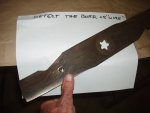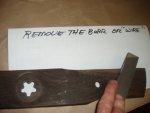BALANCE The use of a 5/8" shanked bolt as a pivot point to check blade balance is specified in the Craftsman owners manual. The writer has used this method and never balanced in 9 years of grinding. Elsewhere in this forum another owner has had similar experience after 11 years grinding. This technique can not detect imbalance of just under 1/2 oz because in the course of this thread the author has assembeld a ball bearing based balance that shows one blade apparently balanced with the bolt method that is off 1/8 oz. The author's second blade that is apparently balanced is off 1/4 oz. The third blade is n/a as a show- and -tell for this thread, and only ground one side. Just below the 1/2 oz. imbalance the bolt method starts to work by allowing the heavy side of the blade to deflect. This raises the question: Is Crafstman telling us that blade imbalance below 1/2 oz is ok? Not balancing the author's tractor in 9 years has apparently not hurt, but last week 2 sump bolts loosened. This tractor is a rough ride over heavily rutted 1 -1/2acres. Let's not forget the "Harley" engine with its "potato" "potato" motion and solid motor mounts. I'll use my new balancer.
Last edited:


